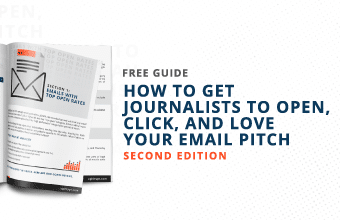Media relations is only one piece of the public relations pie—strategy, planning, research, content, writing, social media, events, activations, monitoring and reporting fill up much of the rest. However, one of the main reasons PR professionals are hired is for media relations prowess, a skill possessed by few, but needed by many.
For those of you who don’t live and breathe public relations day in and day out, media relations is the art of getting press. Whether your client is a footwear company, athletic apparel, mobile app or business service, there comes a time when every product, brand or service, needs some ink to reach its ideal customer base or the masses. Seeing a funky stiletto or to-die-for winter peacoat on the glossy pages of Harper’s Bazaar or the best productivity app on the pages of Fast Company can be instrumental in customer engagement, and ultimately, sales. At the end of the day, public relations efforts are all in vain if they don’t drive sales.
But mastering media relations isn’t easy. It requires time-consuming research, CSI-esque investigative prowess, stellar people skills, forward-thinking, and thick skin. Six years in, and seeing success, here’s my secret sauce:
- First, do not fear journalists. Yes, journalists may get frustrated with PR pros occasionally, but most of them appreciate the editorial help. So many PR professionals fear the journalist on the other end of the email, or phone line, yet it’s important to keep in mind that journalists are regular people trying to do their job, just like you. Try to find something in common with them to lessen your intimidation.
- To help get over a fear of journalists, learn their world. Try working in the media or at least learn as much as you can about whatever type of media you’re pitching. Learn their deadlines, each newsroom role, what kind of pitches they want and don’t want, and their preferable time of day to be contacted.
- Pick up the phone. You can only get to know someone so well via email. Yes, most journalists prefer email to phone pitches, but I encourage you to establish relationships and nurture them with more interpersonal interactions that only in-person or verbal conversations can yield. As generations get more and more tech savvy and the need for human interaction dissolves, a deeper fear of phones is bred. A CNN reporter I work with regularly has never written about my client from an email; rather, five stories have resulted from phone calls. Treat the person on the other end of the phone like you would a friend, and always lead each call with “do you have a minute to chat?” so they know you’re mindful of their scarce, but valuable, time.
- Caveat: do not call a reporter right after you’ve sent a pitch; instead, give them a couple hours or a day to actually read your email first. And, only call a journalist if you feel 100% confident that they’d be interested in your news. Be prepared to reference previous stories they’ve written and why you think they’d care about your news once you get them on the phone. Otherwise, it’s wasting both your time.
- Investigate, with the help of your assistant, Google. Get down and dirty in the depths of Google News. If you’re trying to get coverage for a productivity app, search for anyone who has ever written about your client before, and anyone who has ever written about productivity apps in general. Then search for anyone who has written about apps as a whole, because it means they’re more likely to want to learn about another. Quickly gather email addresses and phone numbers from whatever database you use, drop all those new names into a media list, and go to town.
- Anticipate the news. As much as you can, plan ahead. Seasonal shopping and gift guides, monthly government jobs reports, and political elections can largely be anticipated, for example, allowing you to get your ducks in a row and pitch in advance.
- Be reactive. Breaking news often cannot be anticipated and requires another set of media chops. Make sure you receive breaking news alerts on your phone, so you’re one of the first to be informed (I prefer CNN, Boston Business Journal and WCVB alerts, as I’m Boston based). If you’re working on inserting your client into breaking news stories, forego a media list altogether given the time crunch. If your client or product is relevant to breaking news, head back to your trusty friend Google News and look at who has written about it already. If you only see stories by The New York Times and USA Today, for example, you know the rest will follow suit momentarily. Anticipate those outlets, find the most relevant reporter at the publication, and get to them before they turn in their story. If a dozen articles have already posted, you may be too late, but there’s still hope. Go to those reporters and say “I saw your story about X, and if you plan a follow-up, please consider my client/product,” etc. If it’s a breaking news story that will likely have developments, this strategy works well. Reactive media relations is my favorite part of the job, as it’s an adrenaline-pumping race against time, offering instant gratification if you do it quickly and strategically.
- Not to be underestimated is the art of follow-up. Your job is not done once you’ve hit “send” on your first round of pitches. This is especially true for long-lead media. Pitching a reporter and getting a promising response is only the beginning. Follow up with him or her as often as you can, without annoying them. They usually appreciate the reminder. I’d say 80-90% of stories I’ve landed are a direct result of the second follow-up email, and I continue to be shocked by the amount of PR practitioners that throw in the towel after pitch round number one.
- Learn from your mistakes. Media relations prowess only comes through trial and error. You’ll quickly learn who prefers phone to email, who needs data points or thought leadership experts, high-resolution photos or video examples. Learn and adapt.
- Don’t get discouraged. “No means maybe” has become my media relations motto, which hasn’t let me down yet. If a journalist responds “no, thanks” to a pitch, figure out why. Go back to their articles and try to understand that perhaps you just got their beat wrong, or they’ve already published two articles on the topic and have moved on, or they already have too many products to review and can’t fit yours in, or they just flat-out don’t think your product/service is cool enough. If you’ve exhausted efforts and still can’t figure out why they aren’t interested, ask. Sure, they may not respond, but if they do, it enables you to prepare more catered, relevant pitches for the journalist next time. And better yet, if you can figure out why they said no, and go back to them with a slightly tweaked angle you think might pique their interest, you just might turn a “no” into a “maybe.” And nothing feels more rewarding than turning a “maybe” into a “yes.”
If media relations doesn’t come naturally to you, don’t fret. It’s an art that can be learned. Keep in mind that the White House Press Secretary or lead publicist for Microsoft likely got hung up on at one point, too.
These are the strategies that work for me, but I certainly don’t pretend they’re a prescription for success for all. We each need to find out what works best for us, and it’s my hope that at least one of these strategies helps out a fellow practitioner. Happy pitching, PR nation.
Learn how media databases can help you find the media contacts your looking for.
Read Media Databases: The Ultimate Guide.
Guest contributor Brooks Wallace is an Account Manager / Media Specialist for Hollywood Public Relations.









